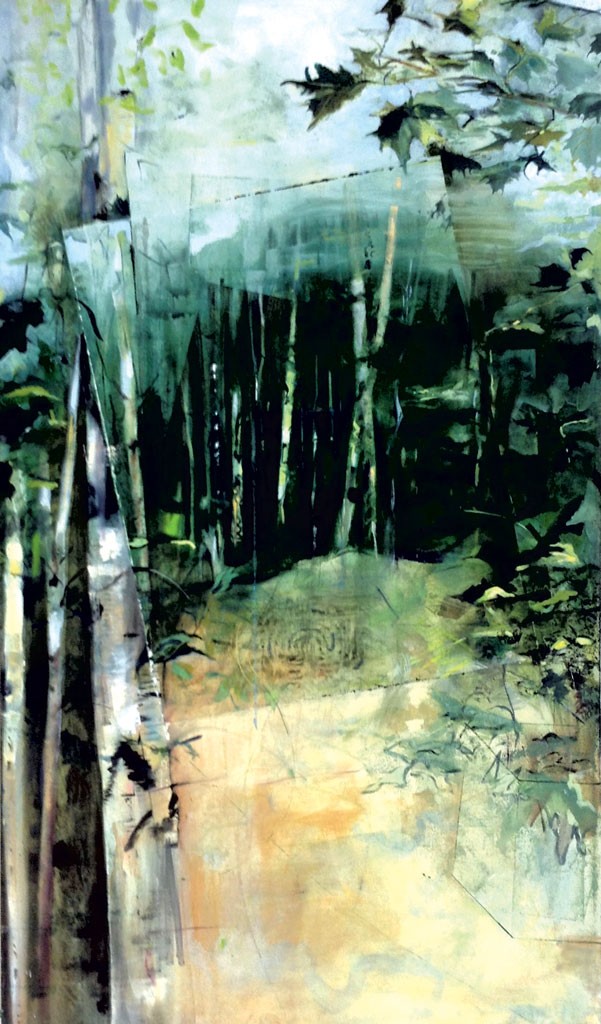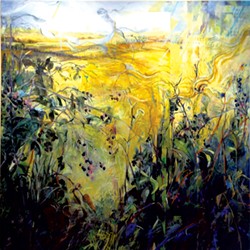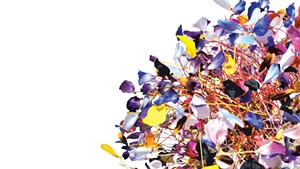
- Courtesy Of Dian Parker
- "Verges" by Bunny Harvey
The White River Gallery's pale yellow walls offer a luminous backdrop for "Fully Involved: Bunny Harvey Paintings," an exhibit of 17 works by the Tunbridge artist. Harvey has filled the 500-square-foot venue with five large-scale oil-on-canvas paintings, eight 12-inch-square oil paintings on panels and four framed archival ink-jet prints. The thrum of a Vermont summer is almost palpable in her work here.
Curator Dian Parker explains that the show's title harks back to cartoonist Ed Koren, a good friend of Harvey's, who once described her approach to her work as "fully involved." A member of Brookfield's volunteer fire department for 27 years, Koren noted that the phrase refers to the moment when a structure is completely engulfed in flames. It also reflects the fact that Harvey's newest work is her most fearless, as she pushes sensory dimensions further than ever. Her recent work is, figuratively speaking, "on fire."
In her newest painting, "Scented August" — at 66 inches square, also the largest on exhibit — Harvey seems to explore all the senses. While only the visual can be rendered in two dimensions, the oil-on-canvas work draws us into the field, evoking the whir and buzz of insects, the hum of farm machinery, the smell of freshly mown hay and manure, and the feel of wind blowing across skin. Rendering these sensations nearly tangible, "Scented August" alone justifies a visit to the White River Gallery.

- Courtesy Of Dian Parker
- "Scented August" by Bunny Harvey
Harvey spent most of her childhood in Vermont, so nature is imprinted in her artistic DNA. Since the 1970s, she has lived in a 1792 farmhouse in Tunbridge, dividing her studio time between there and Providence, R.I. (and, occasionally, Rome and New York City). Harvey identifies and studies plants native to her Vermont property and searches for wild edibles on the land. She paints in a large barn studio on a hill behind her house, opening its massive doors to the elements whenever she can.
Harvey's semiabstract paintings bring the viewer on the same visual journey that the artist takes, whether she's gazing out of those open barn doors in Tunbridge, walking through the fields or at a pond. While this exhibit doesn't capture the full scope of Harvey's prolific output, it does capture summer on canvas. In one work, the wind pushes a sea of tall grasses into a crescendo of waves; in another, blackberries ripen on wild vines; elsewhere, insects search for a sweet fragrance that seems to rise from the canvas.
"Thirty years ago, when my work was basically abstract explorations on archaeological themes, I began a serious layman's study of particle physics," Harvey says in a statement about her work. "Somewhat surprisingly, the attempt to understand subatomic space and time — particularly the relationship between the observer and the observed — led me back to one of the oldest of artistic impulses: the painting and drawing of the landscape."
Harvey's fascination with the subatomic creates an interesting challenge. Her paintings seem expectant, as if awaiting nature's next surprise — a hummingbird darting or a fish jumping, as in the 36-by-66-inch oil "Waiting for Dragonflies." Here, time is a continuum. In "Dragonflies," Harvey uses an arcing line to trace the place where a fish or frog has leaped from the water and disappeared back into it. Her gestural brushstrokes indicate movement and suggest the passing of time. Harvey paints multiple images of a dragonfly hovering just above the waterline of a pond, her brushstrokes indicating where it flew from and where it will go next. She connects the past to the future even as she paints the present.
Using rectangles and other geometric shapes, Harvey aims to draw the viewer's attention to particular areas in her paintings. In "Wind Frame" (66 by 54 inches, oil on canvas), a series of rectangles frame our viewpoint, drawing us deeper into the painting. Here the feeling is one of being tossed by the wind and losing oneself.
Harvey plays with that sense of getting lost, creating landscapes devoid of people that provide a place of reverie. The title "Wind Frame" toys with the notion of capturing the wind and providing a window into nature. These geometric shapes also evoke portals into Harvey's world, where we can share her special relationship with the landscape.
The exhibition also includes four framed archival ink-jet prints, which are lovely but lack the power and depth of the originals. In the original oil version of "Wood Thrush" (66 inches square, not on view), for example, the blood-red carpet propels us into a forest, but those color values are not well distinguished in the print version. The reduction in size to a 22-inch square framed print also reduces the depth of field.
The most successful prints here are "Duet: Hidden Dwellings" and "Luminaries." The more abstract landscape of "Duet" translates well even at one-third scale; it helps that the diptych affords more viewing surface. "Luminaries," a 29-by-21.25-inch charcoal and black pastel on paper, has a commanding simplicity of palette.
The eight 12-inch-square oil-on-panel paintings are alluring, featuring bright colors and a greater sense of abandon through abstraction. Unfortunately, the grouping doesn't work as a whole and seems out of sync with the other works on view. Given Harvey's finely tuned senses, perhaps she chose these works to express greater variety and an interest in continued experimentation.
For years, she has been creating these small panels as a catalog of ideas that evoke a certain playfulness. If the grouping is not so compelling, the individual paintings are uninhibited and sometimes exuberant. Harvey, who recently celebrated 39 years of teaching at Wellesley College, appears to be forging ahead with the sensibility they embody.
"Fully Involved" is a wonderful glimpse into Harvey's lengthy career. Wellesley's Davis Museum gave it the full treatment last fall with "Bunny Harvey: Four Decades," a major retrospective of her work and her legacy as an educator and mentor.
Harvey's career began with a bachelor's and master's degree of fine arts in painting and a master's in teaching from the Rhode Island School of Design. In 1974, the American Academy awarded her the Rome Prize — granted to a select group of artists and scholars each year. When she returned to the U.S. after her intensive two-year residency in Rome, in 1976, Harvey began teaching at Wellesley. Her innate curiosity led her to study particle physics, explore Egypt's desert and develop a fascination with artifacts of ancient civilizations, all of which inform her work to this day.
After 40 years of painting, Harvey is still taking on intellectual challenges and fully involving herself in meeting them with visual solutions.










Comments
Comments are closed.
From 2014-2020, Seven Days allowed readers to comment on all stories posted on our website. While we've appreciated the suggestions and insights, right now Seven Days is prioritizing our core mission — producing high-quality, responsible local journalism — over moderating online debates between readers.
To criticize, correct or praise our reporting, please send us a letter to the editor or send us a tip. We’ll check it out and report the results.
Online comments may return when we have better tech tools for managing them. Thanks for reading.